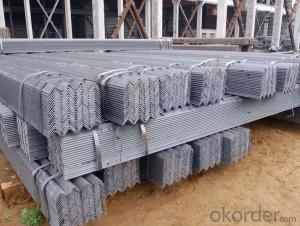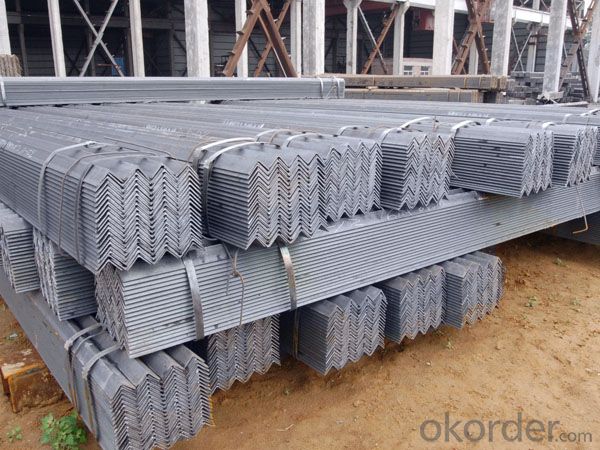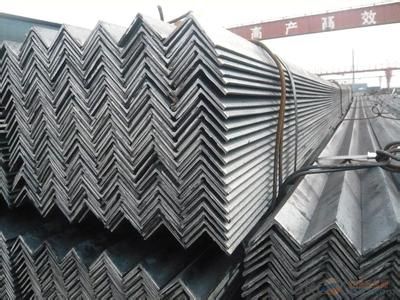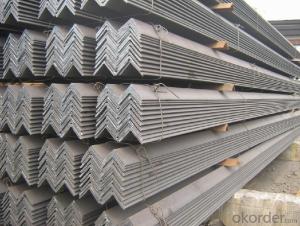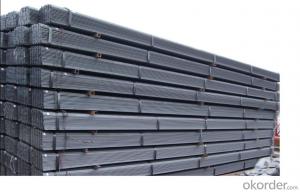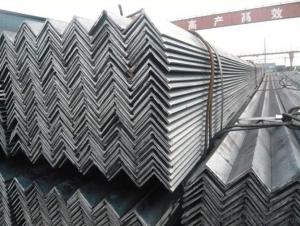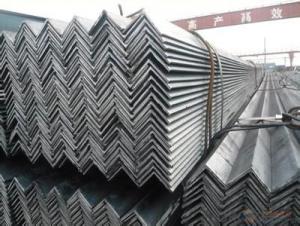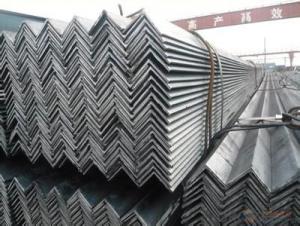Angle steel GB Q235 ASTM A36 high quality
- Loading Port:
- Tianjin
- Payment Terms:
- TT OR LC
- Min Order Qty:
- 25 m.t.
- Supply Capability:
- 20000 m.t./month
OKorder Service Pledge
OKorder Financial Service
You Might Also Like
Angle Steel Details:
| Minimum Order Quantity: | 25mtons | Unit: | m.t. | Loading Port: | China Main Port |
| Supply Ability: | 80000-100000MTS/YEAR | Payment Terms: | TT or LC |
Product Description:
Specifications of Angle Steel
1. Invoicing on theoretical weight or actual weight as customer request
2. Length: 6m, 9m, 12m as following table
3. Sizes
Sizes: 25mm-250mm | ||
a*t | ||
25*2.5-4.0 | 70*6.0-9.0 | 130*9.0-15 |
30*2.5-6.6 | 75*6.0-9.0 | 140*10-14 |
36*3.0-5.0 | 80*5.0-10 | 150*10-20 |
38*2.3-6.0 | 90*7.0-10 | 160*10-16 |
40*3.0-5.0 | 100*6.0-12 | 175*12-15 |
45*4.0-6.0 | 110*8.0-10 | 180*12-18 |
50*4.0-6.0 | 120*6.0-15 | 200*14-25 |
60*4.0-8.0 | 125*8.0-14 | 250*25 |
5. Payment terms:
1).100% irrevocable L/C at sight.
2).30% T/T prepaid and the balance against the copy of B/L.
3).30% T/T prepaid and the balance against L/C
6.Material details:
Alloy No | Grade | Element (%) | |||||
C | Mn | S | P | Si | |||
|
|
|
|
|
|
| |
Q235 | B | 0.12—0.20 | 0.3—0.7 | ≤0.045 | ≤0.045 | ≤0.3 | |
|
|
|
|
|
|
| |
Alloy No | Grade | Yielding strength point( Mpa) | |||||
Thickness (mm) | |||||||
≤16 | >16--40 | >40--60 | >60--100 | ||||
≥ | |||||||
|
|
|
|
|
| ||
Q235 | B | 235 | 225 | 215 | 205 | ||
Alloy No | Grade | Tensile strength (Mpa) | Elongation after fracture (%) | ||||
Thickness (mm) | |||||||
| ≤16 | >16--40 | >40--60 | >60--100 | |||
≥ | |||||||
|
|
|
|
|
|
| |
Q235 | B | 375--500 | 26 | 25 | 24 | 23 | |
Usage & Applications of Angle Steel
According to the needs of different structures, Angle can compose to different force support component, and also can be the connections between components. It is widely used in various building structures and engineering structures such as roof beams, bridges, transmission towers, hoisting machinery and transport machinery, ships, industrial furnaces, reaction tower, container frame and warehouse etc.
Packaging & Delivery of Angle Steel
1. Packing: it is nude packed in bundles by steel wire rod
2. Bundle weight: not more than 3.5MT for bulk vessel; less than 3 MT for container load
3. Marks:
Color marking: There will be color marking on both end of the bundle for the cargo delivered by bulk vessel. That makes it easily to distinguish at the destination port.
Tag mark: there will be tag mark tied up on the bundles. The information usually including supplier logo and name, product name, made in China, shipping marks and other information request by the customer.
If loading by container the marking is not needed, but we will prepare it as customer request.
Production flow of Angle Steel
Material prepare (billet) —heat up—rough rolling—precision rolling—cooling—packing—storage and transportation
- Q: How do steel angles contribute to sustainable transportation infrastructure?
- There are several ways in which steel angles contribute to sustainable transportation infrastructure. To begin with, steel angles are essential in building bridges and highways. Their strength and durability make them perfect for supporting heavy loads and enduring the harsh conditions that transportation infrastructure faces. Consequently, structures constructed with steel angles have a longer lifespan, reducing the need for frequent repairs or replacements. This not only saves money but also lessens the environmental impact associated with the production and disposal of construction materials. Furthermore, the use of steel angles in the construction of transportation infrastructure allows for more efficient designs. Engineers can create innovative and lightweight structures with the versatility of steel angles, resulting in the requirement of less material overall. This leads to reduced energy consumption during the construction process and decreased emissions during transportation and installation. Moreover, steel angles are recyclable. They can be easily recycled and utilized to manufacture new steel products when they reach the end of their lifespan. This lessens the demand for raw materials and minimizes waste sent to landfills. The recycling process also requires less energy and emits fewer greenhouse gases compared to the production of new steel, making it an environmentally friendly choice. Additionally, steel angles can contribute to sustainable transportation infrastructure by facilitating the integration of sustainable technologies. They can support solar panels or wind turbines, enabling the generation of clean energy to power transportation systems. By incorporating renewable energy sources into infrastructure projects, the reliance on fossil fuels can be reduced, resulting in decreased greenhouse gas emissions and a more sustainable transportation system. In conclusion, steel angles have a crucial role to play in sustainable transportation infrastructure. Their strength, durability, recyclability, and ability to support sustainable technologies make them an environmentally friendly choice. By incorporating steel angles in the construction of bridges, highways, and other transportation structures, we can create a more sustainable and resilient transportation system that reduces the environmental impact and promotes a greener future.
- Q: How are steel angles priced?
- Several factors typically influence the pricing of steel angles. One of these factors is the current market price of steel, which is influenced by elements such as supply and demand, global economic conditions, and fluctuations in the costs of raw materials. The price of steel angles can also be affected by their size and dimensions, with larger and thicker angles generally costing more. The grade and quality of the steel used in the angle also play a role in determining its price. Steel angles made from higher-grade materials, such as stainless steel or alloy steel, tend to be more expensive due to their superior strength and resistance to corrosion. Furthermore, the quantity of steel angles being purchased can impact the price. Bulk orders or larger quantities often qualify for volume discounts, which can reduce the overall cost per unit. Lastly, the pricing of steel angles may also take into account transportation and logistics costs. Factors such as shipping distances, handling fees, and any additional services required for delivery can all contribute to the final price. In conclusion, the pricing of steel angles is determined by a combination of market conditions, size and dimensions, grade and quality, quantity ordered, and transportation costs. It is important to consider these factors when evaluating and comparing prices from different suppliers.
- Q: Can steel angles be used for manufacturing playground equipment?
- Indeed, playground equipment can be manufactured using steel angles. Steel angles, renowned for their robustness and endurance, are extensively utilized in construction and manufacturing industries. These angles can be employed to construct the framework and support structures of diverse playground equipment, including slides, climbing frames, and swing sets. The adaptability of steel angles enables the production of secure and steadfast playground equipment capable of enduring rigorous utilization and adverse weather conditions. Furthermore, steel angles can be effortlessly welded, cut, and molded to meet precise design specifications, rendering them an ideal preference for playground equipment manufacturers.
- Q: What are the maximum allowable deflections for steel angles?
- Various factors, such as the type of angle used, material properties, loading conditions, and adherence to design codes and standards, influence the maximum allowable deflections for steel angles. To ensure the structural integrity and functionality of steel angles, deflection limits are established. Excessive deflections can lead to structural instability, reduced load-carrying capacity, and potential failure of the angles. Deflection criteria for different applications are specified by design codes and standards like the American Institute of Steel Construction (AISC). For instance, the AISC 360-16 specification sets deflection limits based on the span length and serviceability requirements of the specific structure. Allowable deflections for steel angles are typically expressed as a fraction of the unsupported span length. Depending on the particular application and loading conditions, typical deflection limits range from 1/240 to 1/360 of the span length. It is important to consider that these deflection limits serve as guidelines and must be evaluated alongside other design considerations such as strength, stability, and dynamic effects. To determine the precise maximum allowable deflections for steel angles in a given project, consulting the relevant design codes and standards and seeking professional engineering advice is crucial.
- Q: Are steel angles resistant to chemical exposure?
- Yes, steel angles are generally resistant to chemical exposure. However, the level of resistance can vary depending on the specific type of steel used and the type and concentration of the chemicals involved. It is important to consult with experts or refer to material compatibility charts to determine the suitability of steel angles for specific chemical environments.
- Q: Can steel angles be used for signposts?
- Yes, steel angles can be used for signposts. Steel angles are commonly used in a variety of structural applications, including signposts. They are strong, durable, and provide excellent support for signs. Steel angles can be easily welded or bolted together to form a sturdy and reliable signpost. Additionally, steel angles are resistant to weather and can withstand harsh environmental conditions, making them suitable for outdoor use. Overall, steel angles are a popular choice for signposts due to their strength, durability, and versatility.
- Q: Can steel angles be used in the construction of religious institutions?
- Yes, steel angles can be used in the construction of religious institutions. Steel angles are commonly used in construction projects due to their strength, versatility, and durability. They provide structural support and can be used in various applications such as framing, roofing, and reinforcing. In the construction of religious institutions, steel angles can be used to create framework for walls, roofs, and floors, as well as to support architectural features such as domes or spires. Additionally, steel angles can be easily fabricated and customized to fit specific design requirements. Overall, steel angles are a reliable and practical choice for constructing religious institutions, ensuring the strength and longevity of the building while allowing for architectural creativity and flexibility.
- Q: How are steel angles protected during transportation and storage?
- To ensure the preservation and quality of steel angles during transportation and storage, various measures are taken. One commonly employed method involves the application of a protective coating or paint to the surfaces of the steel angles. This coating acts as a barrier, shielding the angles from moisture and preventing the occurrence of rust and corrosion. Moreover, plastic wrapping or tarp covering can be utilized to safeguard the angles against dirt, dust, and other contaminants. During transportation, the risk of shifting or falling is minimized by securing the steel angles in bundles or arranging them in a manner that reduces such hazards. Additionally, pallets or skids may be employed to facilitate handling and prevent direct contact with the ground. When stored, it is crucial to keep the steel angles in a well-ventilated and dry area in order to prevent the accumulation of moisture. Furthermore, proper labeling and handling instructions play a vital role in preventing mishandling or damage during transportation. This entails the use of appropriate lifting equipment and avoidance of rough handling that could potentially lead to bending or deformation. By implementing these protective measures, the integrity and quality of steel angles can be upheld throughout the transportation and storage processes, ensuring their readiness for use.
- Q: Can steel angles be used for framing partitions and walls?
- Yes, steel angles can be used for framing partitions and walls. Steel angles are commonly used in construction for their strength and durability. They can be used to create a framework for partitions and walls by providing structural support and stability. Steel angles are versatile and can be easily cut and welded to fit the desired dimensions and angles. They are also resistant to fire, pests, and moisture, making them a suitable choice for framing interior walls and partitions in both commercial and residential buildings.
- Q: Can steel angles be used for solar panel mounting?
- Yes, steel angles can be used for solar panel mounting. Steel angles provide a sturdy and durable framework to securely mount solar panels, ensuring stability and longevity in various weather conditions.
Send your message to us
Angle steel GB Q235 ASTM A36 high quality
- Loading Port:
- Tianjin
- Payment Terms:
- TT OR LC
- Min Order Qty:
- 25 m.t.
- Supply Capability:
- 20000 m.t./month
OKorder Service Pledge
OKorder Financial Service
Similar products
Hot products
Hot Searches
Related keywords
